Input interpretation

2 kg of cyclohexane
Basic properties for 2 kg
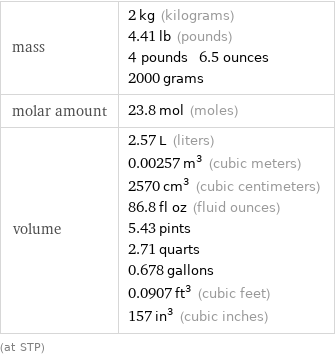
mass | 2 kg (kilograms) 4.41 lb (pounds) 4 pounds 6.5 ounces 2000 grams molar amount | 23.8 mol (moles) volume | 2.57 L (liters) 0.00257 m^3 (cubic meters) 2570 cm^3 (cubic centimeters) 86.8 fl oz (fluid ounces) 5.43 pints 2.71 quarts 0.678 gallons 0.0907 ft^3 (cubic feet) 157 in^3 (cubic inches) (at STP)
Corresponding quantities

sphere radius | 8.494 cm (centimeters) side of a cube | 0.1369 meters
Thermodynamic properties for 2 kg
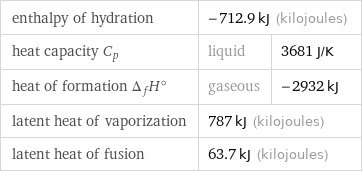
enthalpy of hydration | -712.9 kJ (kilojoules) | heat capacity C_p | liquid | 3681 J/K heat of formation Δ_fH° | gaseous | -2932 kJ latent heat of vaporization | 787 kJ (kilojoules) | latent heat of fusion | 63.7 kJ (kilojoules) |
Units

Energy vs. temperature for 2 kg
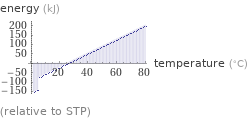
(relative to STP)
Units

Phase change energies for 2 kg from 25 °C

energy required to heat to boiling point | 205 kJ (kilojoules) energy required to convert to vapor | 787 kJ (kilojoules) energy required to heat to boiling point and convert to vapor | 992 kJ (kilojoules) energy released from cooling to freezing point | 71.8 kJ (kilojoules) energy released from converting to solid | 63.7 kJ (kilojoules) energy released from cooling to freezing point and converting to solid | 135 kJ (kilojoules)
Mass composition for 2 kg

C (carbon) | 1.713 kg (85.6%) H (hydrogen) | 0.287 kg (14.4%)

Mass composition for 2 kg
Lewis structure
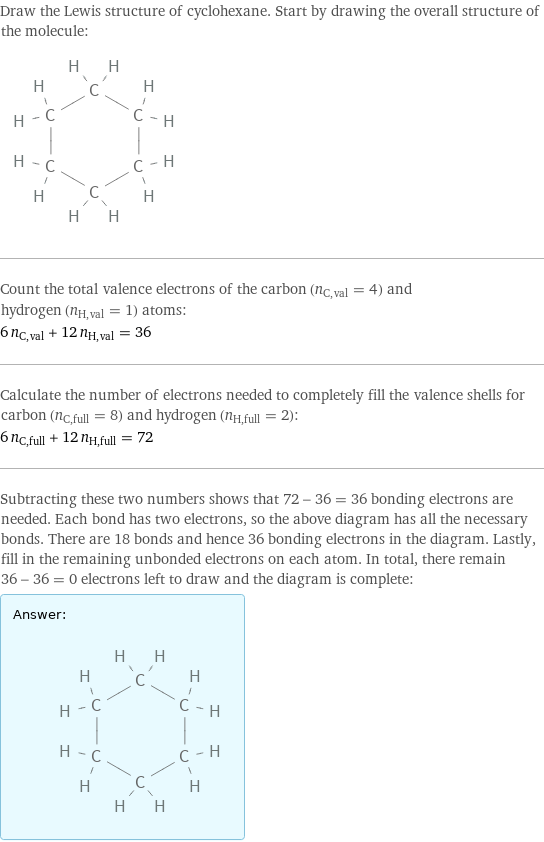
Draw the Lewis structure of cyclohexane. Start by drawing the overall structure of the molecule: Count the total valence electrons of the carbon (n_C, val = 4) and hydrogen (n_H, val = 1) atoms: 6 n_C, val + 12 n_H, val = 36 Calculate the number of electrons needed to completely fill the valence shells for carbon (n_C, full = 8) and hydrogen (n_H, full = 2): 6 n_C, full + 12 n_H, full = 72 Subtracting these two numbers shows that 72 - 36 = 36 bonding electrons are needed. Each bond has two electrons, so the above diagram has all the necessary bonds. There are 18 bonds and hence 36 bonding electrons in the diagram. Lastly, fill in the remaining unbonded electrons on each atom. In total, there remain 36 - 36 = 0 electrons left to draw and the diagram is complete: Answer: | |
Chemical names and formulas
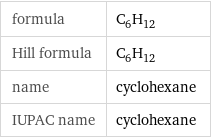
formula | C_6H_12 Hill formula | C_6H_12 name | cyclohexane IUPAC name | cyclohexane
Substance properties
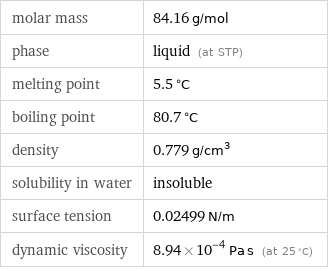
molar mass | 84.16 g/mol phase | liquid (at STP) melting point | 5.5 °C boiling point | 80.7 °C density | 0.779 g/cm^3 solubility in water | insoluble surface tension | 0.02499 N/m dynamic viscosity | 8.94×10^-4 Pa s (at 25 °C)
Units
